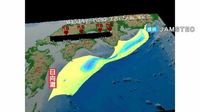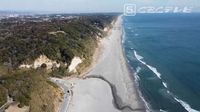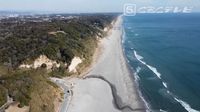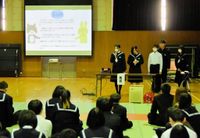As the imminent threat of the Nankai Trough earthquake looms, experts are raising alarms about the devastating impacts that could hit the Pacific coastal regions, particularly in the Toyohashi City area of Aichi Prefecture. This city holds a rich historical narrative, with remnants still visible from previous catastrophic earthquakes that have left profound scars on its landscape.
Yoshida Castle, a cultural landmark rebuilt in 1954, bears witness to the powerful forces of nature with its distinctive stone wall carvings, which feature around 60 crests of historical daimyo and skilled stonemasons. These walls tell tales of resilience and destruction, especially of the notorious 1707 Hoei earthquake. As noted by Takumi Hatanos, a special assistant professor at Nagoya University's Disaster Reduction Research Center, this earthquake heavily damaged structures like Yoshida Castle, as it is remembered that many buildings succumbed to the seismic wrath.
Experts estimate an astonishing 90% chance that a similar Nankai Trough earthquake might occur within the next four decades. The region’s seismic history shows a pattern, as colossal earthquakes have struck about every 100 to 150 years. The Hoei earthquake of 1707 is one such event that left its mark, where although the stone walls withstood the quake, many other structures around the castle crumbled.
Records of destruction exceed even the impressive walls of Yoshida Castle. In the modern storyline, the 1944 Showa Tonankai earthquake resonates particularly with local residents, as it inflicted considerable damage, resulting in the tragic loss of 27 female students in Toyohashi, memorialized by a statue at nearby Ryunenji Temple.
At Ryunenji, a somber commemorative site greets visitors, filled with memories of those who lost their lives. This monument connects past tragedies to contemporary consciousness, urging leaders and citizens alike to reflect on the preparedness needed to mitigate such disasters in the future. The tremors felt in Toyohashi reached levels comparable to a magnitude 7 quake per estimates.
Venturing further beyond the city, the Igo-be coast narrates stories of geographical upheaval and repeated tsunami destruction from the infamous 1854 Ansei Tokai earthquake. From the topographical features visible from above, one can observe the cut cliffs—evidence of the earth's movement—extending 10 kilometers along the shoreline. In conversations with Takumi Hatanos, it emerges that these formations aren't merely aesthetic; they are historical markers of a town that once thrived but was obliterated by relentless waves.
Interestingly, just off this coast, at Mikuriya Shrine, a single boat's survival amid the chaos serves as a poignant reminder of resilience in the face of nature’s fury. The miraculous retention of this boat, held precariously by a pine tree during the devastating tsunami, is commemorated through an offering, a wooden plaque, presented by the boat owner in gratitude for its miraculous survival.
Within the frameworks of disaster preparedness, Toyohashi city officials are proactive, launching extensive strategies to promote earthquake resilience. According to Noboru Saito, an assistant manager in the city's crisis management division, the city initiated an informative project titled “History of Tsunamis in the Higashi-Mikawa Region,” drawing interest toward significant historical events while educating residents about infrastructural safety.
The city boasts an impressive 90% compliance rate in earthquake-resistant building standards, a critical feat achieved through initiatives aimed at promoting structural fortification. Residents seeking guidance on retrofitting their homes receive free consultations, alongside generous financial support covering 80% of construction costs. This proactive approach helps to alleviate concerns from contemporary disasters like the 2024 Noto Peninsula earthquake, which highlighted vulnerabilities and resulted in a tragic loss of life amid collapses.
Despite these measures, as experts underline, awareness and continuous education of citizens remain imperative. As we navigate the paradoxical dance with nature, the question looms—how do we honor the past while fortifying ourselves against the future’s unpredictable tremors? Specialists posit that understanding historical hazards is imperative for safeguarding current and future occupants.
These sentiments resonate with Takumi Hatanos when he mentions the crucial role of historical context in current preparedness initiatives. “Understanding the specific disasters that have occurred here is vital. It pushes communities to introspect on how to safeguard lives against inevitable quakes,” he stated, insisting on comprehensive teaching approaches that highlight the community's past with natural catastrophes.
Ultimately, as the city of Toyohashi stands as a microcosm of broader geological reality, its residents are urged not only to stockpile knowledge but also to prepare practically for potential disasters. With increasing seismic activity predicted, the irrefutable linkage between historical memory and contemporary readiness emerges clearly. As Toyohashi prepares for the inevitable, the lessons learned from the cataclysmic events and the narratives they birthed cultivate a culture of awareness, resilience, and hope for survival.








